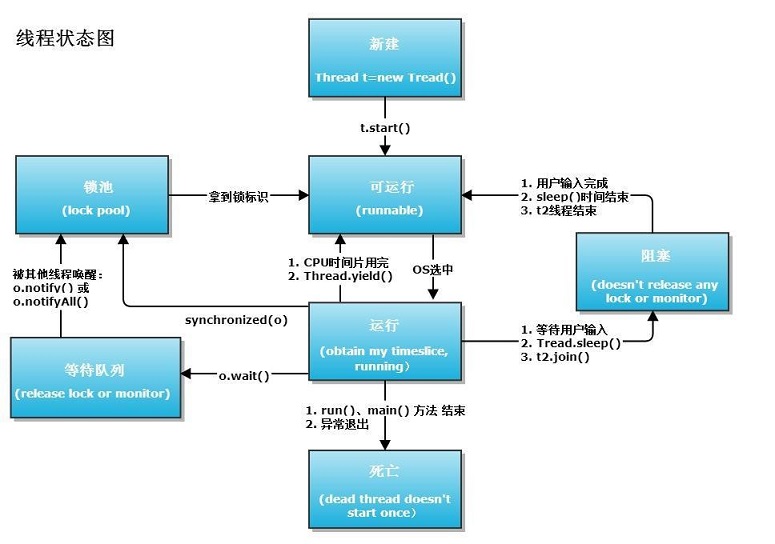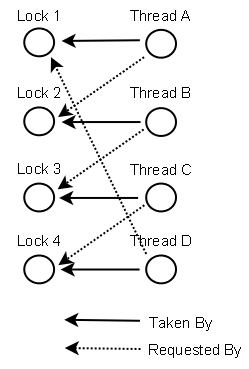Thread
Multi-Task: Parallelism v.s. Concurrency
让计算机在同一时间进行多项任务,一般有两种方式:并行(Parallelism)和并发(Concurrency)。
并行(Parallelism):把一项任务拆分成可以同时执行的多个子任务,交给不同的运算单元去执行。 举例:大数据分析,TB级别的数据量,交给一个单核CPU来算,肯定很慢,那就换电脑,改成8核CPU,8个同时算就快了很多。如果还嫌慢,那就加电脑,10台8核CPU电脑,也就是80个CPU,速度又提高了不少。(当然算完了肯定要合并结果,这是Map Reduce的内容以后另说)
并行就是,客服中心有8个电话,公司雇了8个员工,每人分1个电话。

并发(Concurrency):通过CPU调度算法,同一时间内运行多个进程/线程,在各个程序之间来回切换执行。 为什么会有并发?为什么要来回倒腾?一个活干完了再干下一个活不行吗?真不行,比如我们一边写博客,一边听歌,一边下载电影,同时运行了三个程序。 如果没有并发,只能开一个程序,用户体验就差很多。而且关键是,这三个任务其实占用的CPU,内存都不高,只有最后一个下电影,对网速和硬盘读写有较大的要求,计算机完全可忙得过来。
并发就是,客服中心有8个电话,公司雇了1个超级员工,让他1个人接8个电话,不断换着讲。

Concurrency - Benefits and Costs
并发是为了程序运行得更快。启用多个线程,并互相切换,可以减少因某个线程阻塞而等待的时间。 但是,由于上下文切换也有开销,所以并不是一定并发比串行要快。
用Lmbench3测量上下文切换时长,用vmstat测量上下文切换次数。
Concurrency Implementation: Process v.s. Thread
说说Concurrency,一般实现有两种手段:多线程(Thread)和多进程(Process)。
Thread v.s. Process
- A Process usually contains multiple threads at the same time.
- Threads (of the same process) run in a shared memory space, while processes run in separate memory spaces.
多进程(Process)很好理解,Windows打开任务管理器可以看到多个正在执行的进程。 这里主要谈多线程(Thread),因为它更容易编程实现,效率更高。
Thread: Benefits and Costs
Benefit
- better resource utilization 资源利用率高
- more responsive design 系统更高的响应率
Cost
- more complex design 设计复杂度增加
- context switching overhead 线程切换负担
- issues when not thread safe 未保证多线程安全的情况下可能会带来问题
Java Thread State
线程的状态:
- new
- runnable
- ready
- running
- waiting
- timed waiting
- waiting
- blocked
- terminated
注:有的地方把 waiting 和 blocked 都看作是阻塞,需要注意。

总结:
- 正常运行的线程:
- 创建 ->
newstate - start() ->
runnable - readystate - 被scheduler排到了,获取CPU资源 ->
runningstate - 运行完 ->
terminatedstate
- 创建 ->
- sleep(作用于本线程,自己”睡”若干时间):
sleep(timeout)->timed waitingstate- timeout完了之后 ->
runnablestate
- wait:(作用于某个Object,我等这个Obj,直到它通知我好了,我才会继续往下走)
obj.wait(timeout)->timed waitingstate- timeout完了之后 -> 相当于进入了
waitingstate,等待obj.notify() obj.notify()->blockstate,waiting for the monitor lock to enter/re-enter a synchronized block/method- 获取monitor lock ->
runnablestate
- join:(作用于某个Thread,我等这个Thread终结,才会继续往下走)
t.join(timeout)->timed waitingstate- timeout完了之后 -> 相当于进入了
waitingstate - 等待的那个thread终结了之后 ->
runnablestate
经常问到的几个问题:
sleep()和wait()有什么区别:- 都可以用来放弃CPU一定的时间,不同点在于如果线程持有某个对象的监视器moniter,
sleep()不会放弃这个对象的监视器,wait()会放弃这个对象的监视器 sleep()完了之后就进入Runnable状态wait()完之后还在Blocked状态,要等待获取monitor lock
- 都可以用来放弃CPU一定的时间,不同点在于如果线程持有某个对象的监视器moniter,
- 线程中断
interrupt了怎么做可以让它继续运行:- catch住
InterruptedException,然后决定是否要中止程序,或者让它继续运行下去
- catch住
start()和run()有什么区别:start()不堵塞;它call了run(),完了程序就继续执行下去了,不会等待线程运行返回结果run()会堵塞等待;它开始执行线程内容,会等线程运行完毕才继续执行下面的内容
Runnable接口和Callable接口的区别:Runnable接口中的run()方法的返回值是void,它做的事情只是纯粹地去执行run()方法中的代码而已Callable接口中的call()方法是有返回值的,是一个泛型,和Future,FutureTask配合可以用来获取异步执行的结果,或者当等待时间太长时取消任务
- 如何在两个线程之间共享数据:
- 通过在线程之间共享对象就可以了,比方说阻塞队列
BlockingQueue就是为线程之间共享数据而设计的。
- 通过在线程之间共享对象就可以了,比方说阻塞队列
Java Thread Interrupt
线程中断
当一个线程调用interrupt()后,表示告诉当前线程:你把手中的活停一下,可能要干些别的事了。如下:
public static void main(String[] args) throws InterruptedException {
ThreadA t = new ThreadA();
t.start();
Thread.sleep(3000);
t.interrupt();
}
这个时候,当前线程干了一件事:把Thread.currentThread().isInterrupted()的值置为true。然后,就看当前线程怎么处理这个flag了。
- 一种可能,编程者检查了这个flag,然后使用一段其它的处理逻辑。
- 另一种可能,编程者检查了这个flag,然后抛出一个
InterruptedException。(比如Thread.sleep(),Object.wait(),Thread.join()都会这么干,并且将flag复位) - 还有一种,编程者直接忽略掉这个flag,那一切无事发生。
下例,是第1种情况:
public class ThreadA extends Thread{
public void run(){
while(true){
if(Thread.currentThread().isInterrupted()){
System.out.println("Someone interrupted me.");
return;
}
else{
System.out.println("Thread is Going...");
}
}
}
}
下例,是第2种情况:需要注意的是,InterruptedException是由sleep(100)抛出的。
public void run() {
while (true) {
try {
sleep(100);
System.out.println("Thread is Going...");
} catch (InterruptedException e) {
//e.printStackTrace();
System.out.println("Someone interrupted me. I can't sleep.");
return;
}
}
}
中断使用场景:
- 在某线程中,调用了
Thread.sleep(10000)等10s,实际发现不需要10s,于是使用中断提前唤醒。 - 线程A调用
join()方法等待线程B执行结束,但是线程B发现自己短时间无法结束,于是使用中断,告诉线程A别等我了。
参考 -> 理解java线程的中断 https://blog.csdn.net/canot/article/details/51087772 和 https://docs.oracle.com/javase/tutorial/essential/concurrency/interrupt.html
Java Thread Example
创建线程对象的方式
- 继承
Thread类 - 实现
Runnable接口 - 实现
Callable接口
创建线程的方式
- 单个线程
Thread - 线程池
Executors
Thread Programming Steps:
- create (thread) objects with thread features (implement Runnable / implement Callable / extends Thread)
- override
run() - (optional) override
start(); usually the thread instantiation happens here
- override
- create a thread with (thread objects)
- call
Thread.start()orExecutors.submit()
- call
e.g.
// Part 1: extends Thread
class PrimeThread extends Thread {
long minPrime;
PrimeThread(long minPrime) {
this.minPrime = minPrime;
}
public void run() {
// compute primes larger than minPrime
...
}
}
...
PrimeThread p = new PrimeThread(143);
p.start();
// Part 2: implements Runnable
class PrimeRun implements Runnable {
long minPrime;
PrimeRun(long minPrime) {
this.minPrime = minPrime;
}
public void run() {
// compute primes larger than minPrime
...
}
}
...
PrimeRun p = new PrimeRun(143);
new Thread(p).start();
// Part 3: using Executors
ExecutorService executor = Executors.newSingleThreadExecutor();
executor.submit(() -> {
String threadName = Thread.currentThread().getName();
System.out.println("Hello " + threadName);
});
Thread Issues
多线程共享内存空间,即Thread之间资源共享,一个Thread可以access到另一个Thread的资源,这里就可能会出问题。
- Race Condition竞争: Race condition occurs when multiple threads update shared resources. 两个线程同时要更新一个资源,你先来还是我先来?谁都不相让,自然要打起来。
- Deadlock死锁: Two or more threads are blocked forever, waiting for each other.
e.g. 两个线程同时对String和int进行大量(1000次)操作,预期的结果是:count=1000,string存放了0-999。 但是由于非线程安全,线程1,2同时操作变量,有一个的结果就被“丢掉”了。
public class ConcurrencyIssueTest {
String string = "";
int count = 0;
void inc() {
string += (","+count++);
}
public static void main(String args[]) throws Exception {
ConcurrencyIssueTest test = new ConcurrencyIssueTest();
ExecutorService executor = Executors.newFixedThreadPool(2);
IntStream.range(0, 1000).forEach(i -> executor.submit(test::inc));
executor.shutdown();
executor.awaitTermination(60, TimeUnit.SECONDS);
System.out.println(test.count);
System.out.println(test.string);
}
}
输出如下:
999
...277,279,281,283,285,287...
为了防止出现这些问题,需要在设计开发的时候特别注意,保证Thread Safe。
Thread Safe
Thread safety: The program state (fields/objects/variables) behaves correctly when multiple simultaneous threads are using a resource. 保证一个资源同时被多个进程读写时表现正常。
那么如何实现(资源的)Thread Safe呢?
- 隔离(自己玩自己的,互不干扰)use a pattern whereby each thread context is isolated from others
- 局部变量
- for example,
ThreadLocalclass
- 加锁(同一时刻,只有一个人可以修改),restrict access to a resource to a single thread at a time
- for example,
synchronizedkeyword (monitor/intrinsic lock) - for example,
ReentrantLock java.util.concurrent.ConcurrentHashMap(lock on segment)
- for example,
- CAS(如果修改,从头再来,避免加锁开销),适合并发量不高的情况
java.util.concurrent.atomic(CAS compare-and-swap)java.util.concurrent.BlockingQueueSemaphores(CAS -> AQS AbstractQueuedSynchronizer)
- https://www.cnblogs.com/lixinjie/p/a-answer-about-thread-safety-in-a-interview.html
Deadlock Prevention
Lock Ordering: make sure that all locks are always taken in the same order by any thread
典型反面例子
Thread 1:
lock A
wait B
Thread 2:
lock B
wait A
Lock Timeout: if a thread does not succeed in taking all necessary locks within the given timeout, it will backup, free all locks taken, wait for a random amount of time and then retry.
Deadlock Detection: every time a thread takes a lock it is noted in a data structure (map, graph etc.) of threads and locks. Additionally, whenever a thread requests a lock this is also noted in this data structure.
When a thread requests a lock but the request is denied, the thread can traverse the lock graph to check for deadlocks.

Tools:
- jstack
- alibaba arthas
- jconsole / jvisualvm
Other Topic
- [[consumer-producer]]
- [[executor]]
- [[lock]]
- [[synchronized]]
- [[volatile]]
